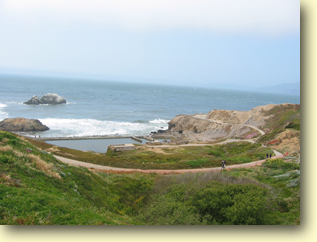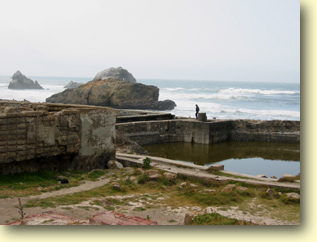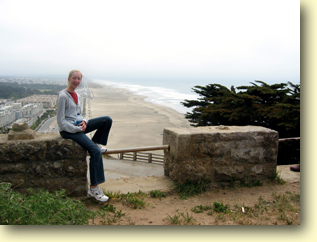|
San Francisco: Land’s End tempts with a ghostly history
By Joyce Kiefer
 At Land’s End in San Francisco, the sea licks through a cave opening in the sides of an abandoned train tunnel. A terrace of swimming pools like Roman ruins lies directly below at the edge of the pounding waves. If you pack your imagination along with your water bottle, you’ll know that at Land’s End you’re in the land of ghosts. At Land’s End in San Francisco, the sea licks through a cave opening in the sides of an abandoned train tunnel. A terrace of swimming pools like Roman ruins lies directly below at the edge of the pounding waves. If you pack your imagination along with your water bottle, you’ll know that at Land’s End you’re in the land of ghosts.
The baths and estate built by Adolph Sutro, the stumps of shipwrecks, a chunk of the shell-riddled bridge of a World War II heavy cruiser – all of these call up the plucky spirits of times past, especially if a shroud-like fog hangs over this westernmost point of The City.
My granddaughter Allyson chose this place for her birthday outing with my husband and myself.
SUTRO HISTORY
We began with a picnic at Sutro Heights Park on Point Lobos Dr. and Forty-eighth Avenue. We parked the car and walked everywhere from here. A nineteenth century entrepreneur extraordinaire, Adolph Sutro built a 21-acre estate on this site in the 1890’s and opened its gardens to the public. At that time he also purchased the existing Cliff House restaurant down the hill and remodeled it into an 8-story Victorian gingerbread masterpiece. Across the street from his home he built an amusement park on Merrie Way.
 Below at the edge of the water he built Sutro Baths big enough to accommodate 10,000 people. How would he get them to the "outside lands" to enjoy all he had built? He built a railroad that ended through the tunnel above the baths. Below at the edge of the water he built Sutro Baths big enough to accommodate 10,000 people. How would he get them to the "outside lands" to enjoy all he had built? He built a railroad that ended through the tunnel above the baths.
These places are now part of the Golden Gate National Recreation Area. Sutro made his fortune in tunnels. He left his native Prussia for California in 1850, the year after gold was discovered. As an engineer, he was more interested in the silver mines of Nevada. He designed, built and rented out a series of tunnels to ventilate and drain the mines of the Comstock Lode. He returned to San Francisco in 1879, became a land developer, and served as mayor for two years.
PARK
We spread our picnic in Sutro Heights Park on a spot with a view of the Great Highway that runs parallel to an endless stretch of cold, sandy beach. Long frills of white breakers extended down the coast. We had driven north on the Great Highway and followed its curve past the Cliff House onto Point Lobos Drive. The park came up immediately on the right. Sutro had an even better view from his house. We walked up to the site and peered straight down at the ocean.
 Next we crossed the street to the parking lot under construction on Merrie Way. Close your eyes and imagine when the carnival that Sutro built stood here instead of a parking lot. Picture the 100’ diameter Firth Wheel with 16 carriages to take passengers on 20-minute rides that overlooked the Baths and the sea. Or put yourself on the Haunted Swing, a full scale optical illusion. Next we crossed the street to the parking lot under construction on Merrie Way. Close your eyes and imagine when the carnival that Sutro built stood here instead of a parking lot. Picture the 100’ diameter Firth Wheel with 16 carriages to take passengers on 20-minute rides that overlooked the Baths and the sea. Or put yourself on the Haunted Swing, a full scale optical illusion.
The riders sat on a glider that moved in one direction while the room itself moved the opposite way. The playland was first named the "Sutro Pleasure Grounds" but was later called "Merrie Way." Like his Cliff House which burned down in 1907, his Pleasure Grounds were short lived. Photos taken in 1910 show the attractions in disrepair.
Although I grew up in the San Francisco Bay Area, I had never seen Sutro Baths. Built in 1896, they closed in 1952 and burned down in 1966. Allyson has always been fascinated by the framed picture her other grandparents have of the baths in their glory days, complete with palms and Egyptian decor. I tried to imagine 7,000 spectators watching 10,000 swimmers, as Sutro had in mind. To reach the ruins we walked down the hill past Louis Restaurant and descended the stairs. Paths led us around the edges of what’s left of the six saltwater pools and the freshwater one, now filled with murky water of indeterminate mixture. With the waves pounding so close, the remains of the swimming pools seemed more like tide pools.
We followed the path up through the tunnel and looked at the twisted, rusted remains of the train track that once ran along the cliffs to Presidio Av and California. Landslides brought it down in 1925. A spur path leads to Point Lobos, another view point to enjoy if the wind isn’t too fierce. We continued up the hill to the Coastal Trail. A new set of ghosts seemed to rise from the place where the bay and ocean meet – shipwrecks!
We spotted the remains of an engine block from the Frank Buck and saw bits and pieces of other ships when we reached the memorial to the USS San Francisco up the steps to the right of the trail. GGRMA docents give a shipwreck hike once a month by reservation.
World War II Remains
It was time to visit the inevitable ghosts of World War II. We could almost see the battleships firing at each other, as we peered through the shell holes on the piece of the ship’s bridge that comprises the monument. The USS San Francisco was a heavy cruiser that fought its way down a line of Japanese battleships in Guadalcanal on November 13, 1942. At point blank range the battleship Hiei fired 14" shells that devastated her bridge, causing the ship to lose control.
She absorbed 45 major hits and lost her admiral and captain plus 106 sailors. Nevertheless, the USS San Francisco sunk one Japanese ship, seriously damaged two others, and made it back to port. Allyson shared our amazement at the shell-torn fragment of the ship. I had an uncle stationed in Okinawa, so for me the battles in the Pacific and the entire war are quite real. For Allyson, the war is a TV special by Ken Burns. We walked back to the car around Merrie Way in hazy sunlight. Did we see an outline of Adolph Sutro clasping his hands together in a gesture of success?
****
Noteworthy Information
To reserve a spot on the monthly docent-led shipwreck walks, call the GGNRA at (415) 561-4323.
For more on Land’s End, go to http://www.parksconservancy.org/visit/park.asp?park=52
and to http://www.outsidelands.org/merrie-way.php
Joyce Kiefer is a Bay Area travel writer and loves to take her granddaughters on great adventures.
[ Back to Top ] [ Back to Index ]
|



